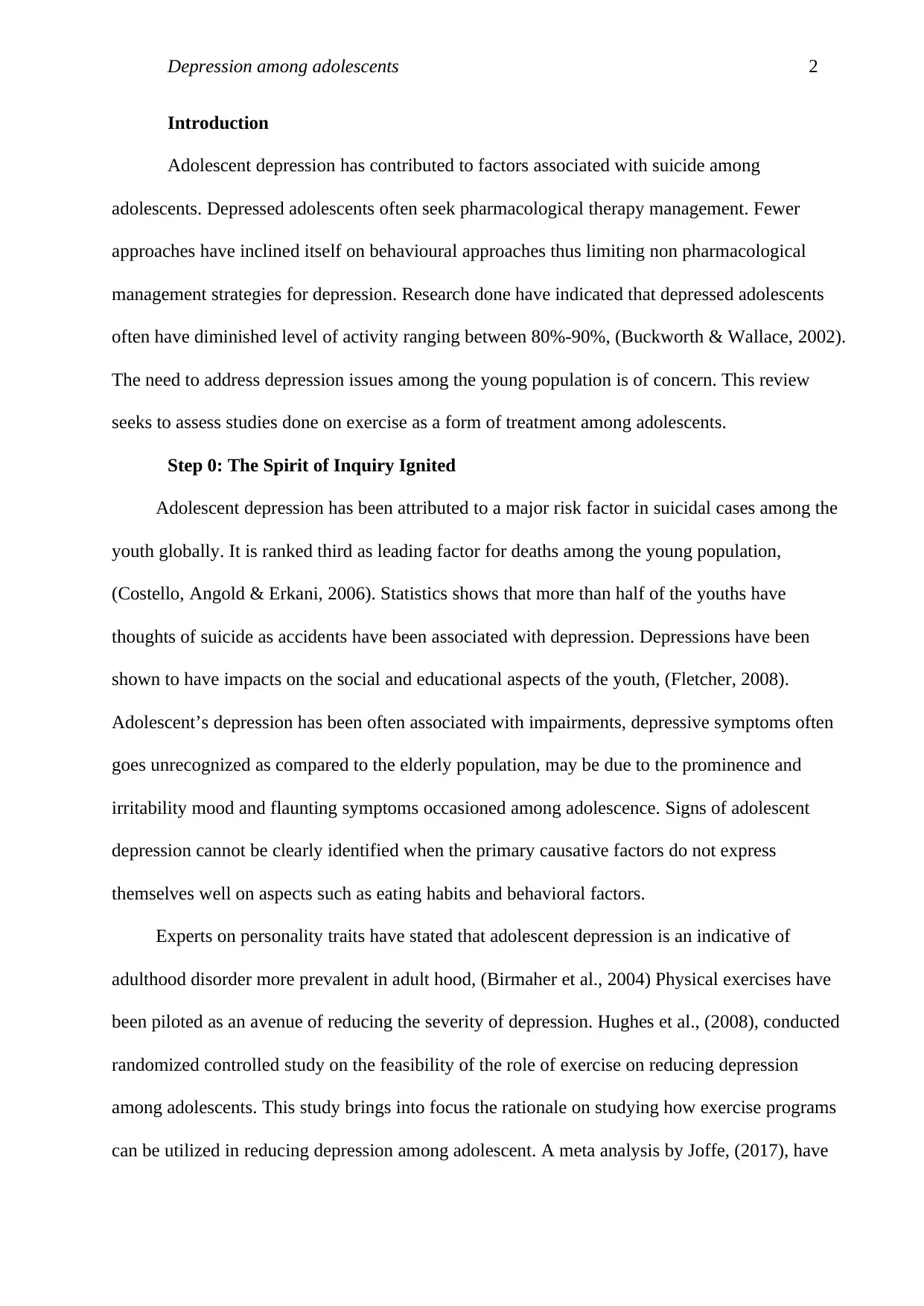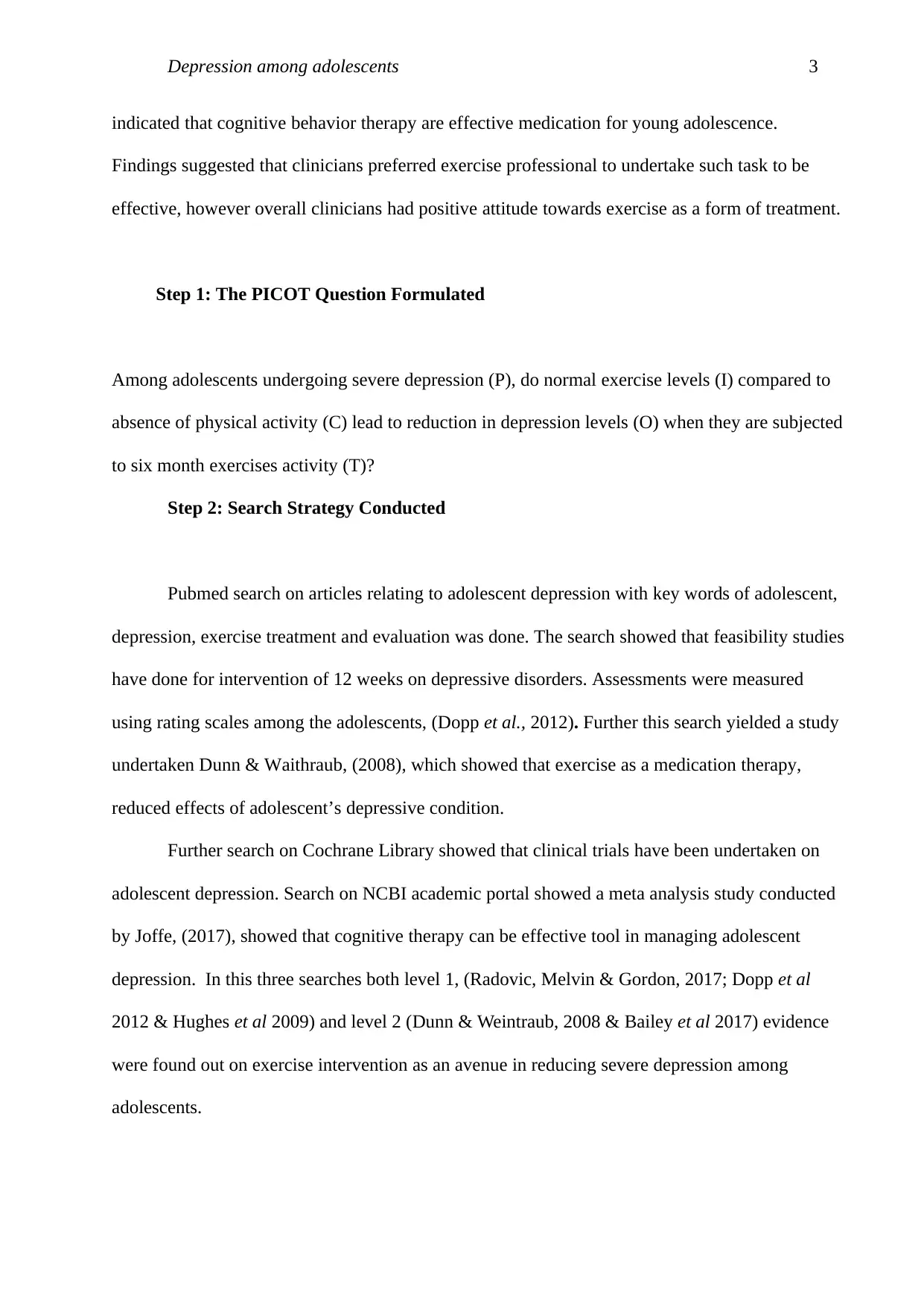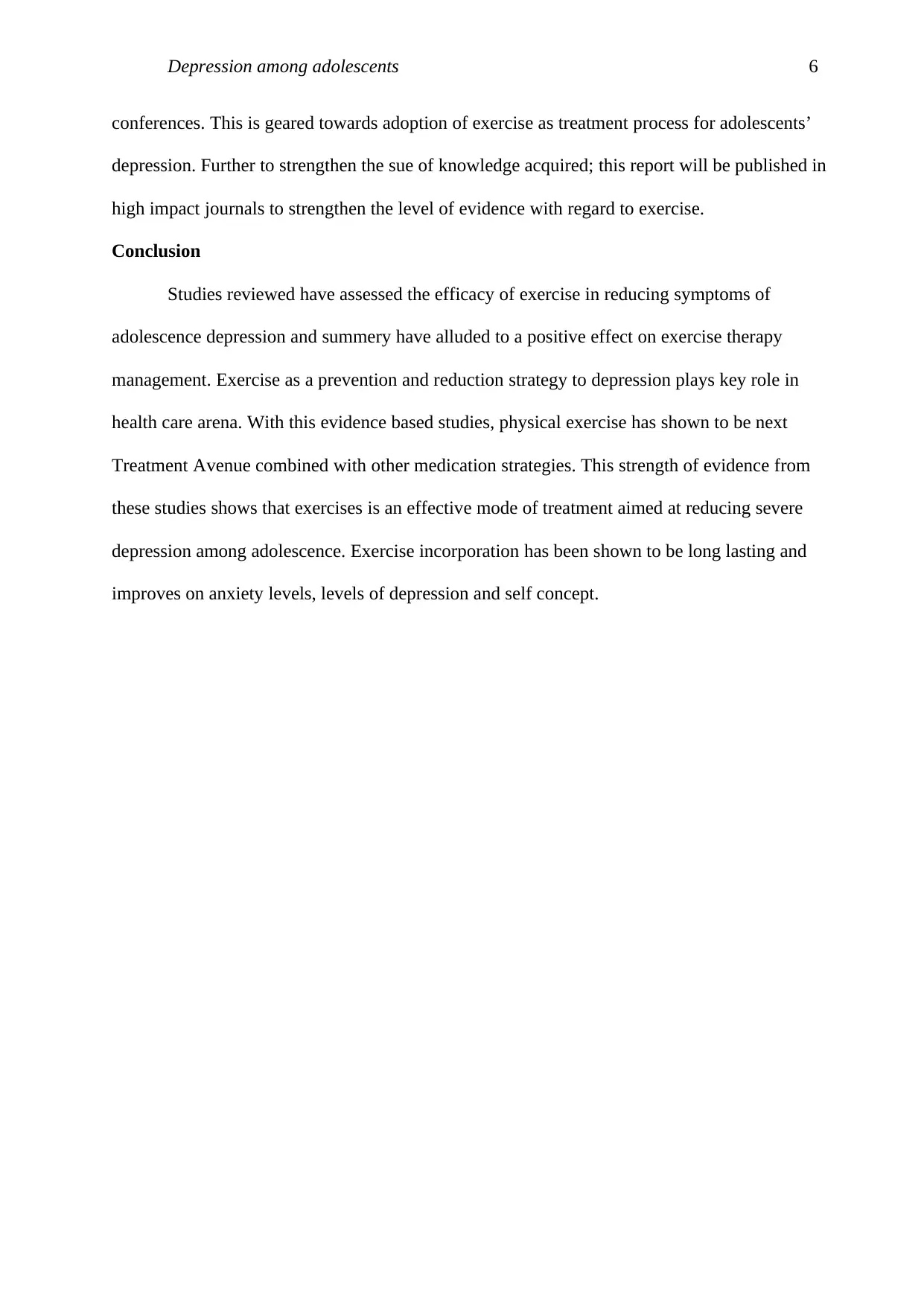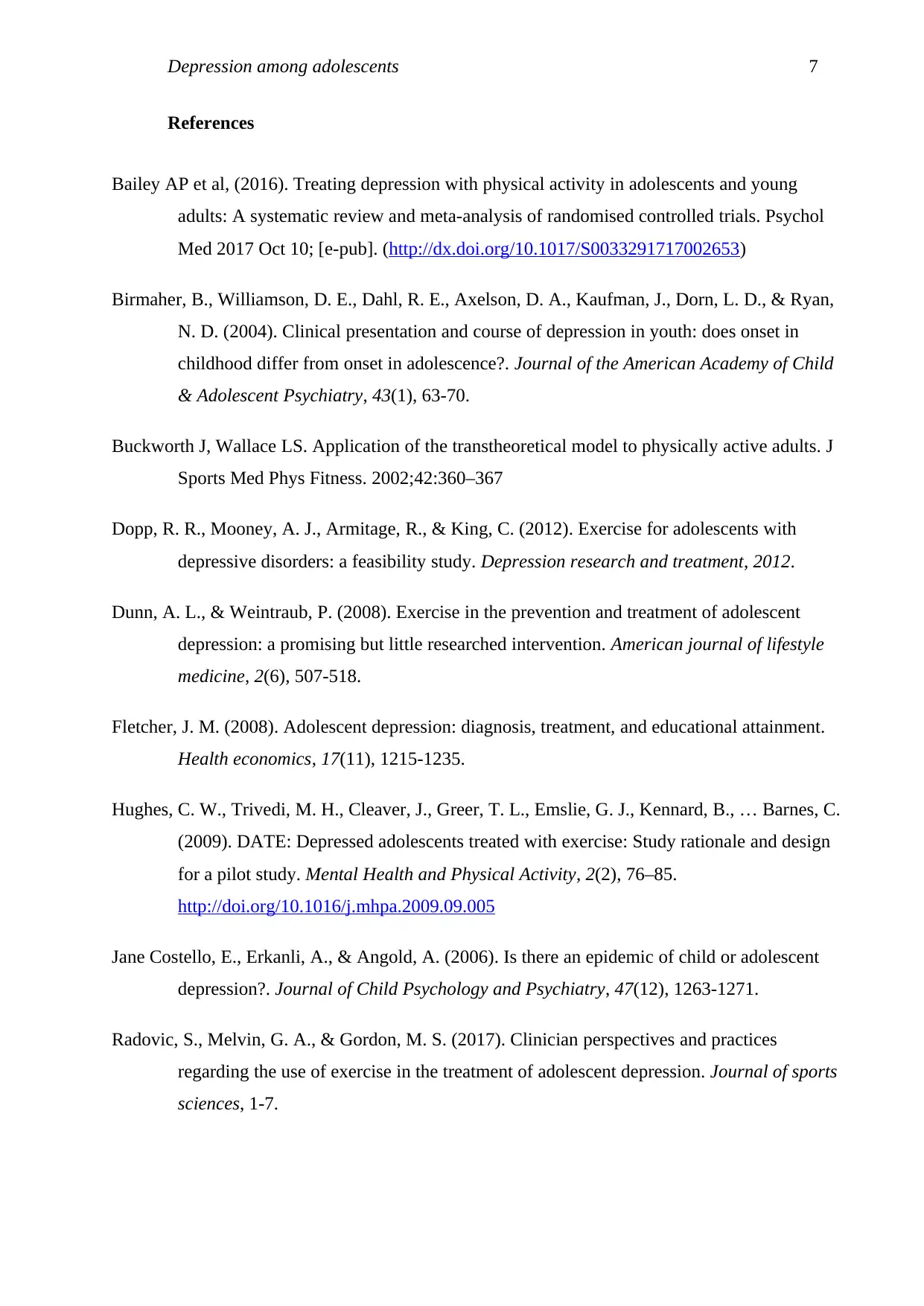Project Task: Reviewing Exercise Therapy for Adolescent Depression
VerifiedAdded on 2023/06/15
|7
|1894
|255
Report
AI Summary
This report assesses the efficacy of exercise as a treatment for adolescent depression, addressing the rising rates of depression and suicide among adolescents and the limitations of pharmacological treatments. It explores studies on exercise interventions, highlighting their potential to reduce depression levels. The review follows a structured approach, including formulating a PICOT question, conducting literature searches, critically appraising evidence, integrating evidence with clinical expertise and patient preferences, evaluating outcomes, and outlining project outcomes and dissemination strategies. The findings suggest that structured exercise can be a beneficial non-pharmacological approach to managing adolescent depression, supported by both randomized controlled trials and quasi-experimental studies. The report emphasizes the importance of involving trained physical exercise professionals and disseminating these findings to healthcare professionals to promote the adoption of exercise as a treatment option.

Running Head; Project Task
UNIVERSITY:
Course
Task
UNIVERSITY:
Course
Task
Paraphrase This Document
Need a fresh take? Get an instant paraphrase of this document with our AI Paraphraser

Depression among adolescents 2
Introduction
Adolescent depression has contributed to factors associated with suicide among
adolescents. Depressed adolescents often seek pharmacological therapy management. Fewer
approaches have inclined itself on behavioural approaches thus limiting non pharmacological
management strategies for depression. Research done have indicated that depressed adolescents
often have diminished level of activity ranging between 80%-90%, (Buckworth & Wallace, 2002).
The need to address depression issues among the young population is of concern. This review
seeks to assess studies done on exercise as a form of treatment among adolescents.
Step 0: The Spirit of Inquiry Ignited
Adolescent depression has been attributed to a major risk factor in suicidal cases among the
youth globally. It is ranked third as leading factor for deaths among the young population,
(Costello, Angold & Erkani, 2006). Statistics shows that more than half of the youths have
thoughts of suicide as accidents have been associated with depression. Depressions have been
shown to have impacts on the social and educational aspects of the youth, (Fletcher, 2008).
Adolescent’s depression has been often associated with impairments, depressive symptoms often
goes unrecognized as compared to the elderly population, may be due to the prominence and
irritability mood and flaunting symptoms occasioned among adolescence. Signs of adolescent
depression cannot be clearly identified when the primary causative factors do not express
themselves well on aspects such as eating habits and behavioral factors.
Experts on personality traits have stated that adolescent depression is an indicative of
adulthood disorder more prevalent in adult hood, (Birmaher et al., 2004) Physical exercises have
been piloted as an avenue of reducing the severity of depression. Hughes et al., (2008), conducted
randomized controlled study on the feasibility of the role of exercise on reducing depression
among adolescents. This study brings into focus the rationale on studying how exercise programs
can be utilized in reducing depression among adolescent. A meta analysis by Joffe, (2017), have
Introduction
Adolescent depression has contributed to factors associated with suicide among
adolescents. Depressed adolescents often seek pharmacological therapy management. Fewer
approaches have inclined itself on behavioural approaches thus limiting non pharmacological
management strategies for depression. Research done have indicated that depressed adolescents
often have diminished level of activity ranging between 80%-90%, (Buckworth & Wallace, 2002).
The need to address depression issues among the young population is of concern. This review
seeks to assess studies done on exercise as a form of treatment among adolescents.
Step 0: The Spirit of Inquiry Ignited
Adolescent depression has been attributed to a major risk factor in suicidal cases among the
youth globally. It is ranked third as leading factor for deaths among the young population,
(Costello, Angold & Erkani, 2006). Statistics shows that more than half of the youths have
thoughts of suicide as accidents have been associated with depression. Depressions have been
shown to have impacts on the social and educational aspects of the youth, (Fletcher, 2008).
Adolescent’s depression has been often associated with impairments, depressive symptoms often
goes unrecognized as compared to the elderly population, may be due to the prominence and
irritability mood and flaunting symptoms occasioned among adolescence. Signs of adolescent
depression cannot be clearly identified when the primary causative factors do not express
themselves well on aspects such as eating habits and behavioral factors.
Experts on personality traits have stated that adolescent depression is an indicative of
adulthood disorder more prevalent in adult hood, (Birmaher et al., 2004) Physical exercises have
been piloted as an avenue of reducing the severity of depression. Hughes et al., (2008), conducted
randomized controlled study on the feasibility of the role of exercise on reducing depression
among adolescents. This study brings into focus the rationale on studying how exercise programs
can be utilized in reducing depression among adolescent. A meta analysis by Joffe, (2017), have

Depression among adolescents 3
indicated that cognitive behavior therapy are effective medication for young adolescence.
Findings suggested that clinicians preferred exercise professional to undertake such task to be
effective, however overall clinicians had positive attitude towards exercise as a form of treatment.
Step 1: The PICOT Question Formulated
Among adolescents undergoing severe depression (P), do normal exercise levels (I) compared to
absence of physical activity (C) lead to reduction in depression levels (O) when they are subjected
to six month exercises activity (T)?
Step 2: Search Strategy Conducted
Pubmed search on articles relating to adolescent depression with key words of adolescent,
depression, exercise treatment and evaluation was done. The search showed that feasibility studies
have done for intervention of 12 weeks on depressive disorders. Assessments were measured
using rating scales among the adolescents, (Dopp et al., 2012). Further this search yielded a study
undertaken Dunn & Waithraub, (2008), which showed that exercise as a medication therapy,
reduced effects of adolescent’s depressive condition.
Further search on Cochrane Library showed that clinical trials have been undertaken on
adolescent depression. Search on NCBI academic portal showed a meta analysis study conducted
by Joffe, (2017), showed that cognitive therapy can be effective tool in managing adolescent
depression. In this three searches both level 1, (Radovic, Melvin & Gordon, 2017; Dopp et al
2012 & Hughes et al 2009) and level 2 (Dunn & Weintraub, 2008 & Bailey et al 2017) evidence
were found out on exercise intervention as an avenue in reducing severe depression among
adolescents.
indicated that cognitive behavior therapy are effective medication for young adolescence.
Findings suggested that clinicians preferred exercise professional to undertake such task to be
effective, however overall clinicians had positive attitude towards exercise as a form of treatment.
Step 1: The PICOT Question Formulated
Among adolescents undergoing severe depression (P), do normal exercise levels (I) compared to
absence of physical activity (C) lead to reduction in depression levels (O) when they are subjected
to six month exercises activity (T)?
Step 2: Search Strategy Conducted
Pubmed search on articles relating to adolescent depression with key words of adolescent,
depression, exercise treatment and evaluation was done. The search showed that feasibility studies
have done for intervention of 12 weeks on depressive disorders. Assessments were measured
using rating scales among the adolescents, (Dopp et al., 2012). Further this search yielded a study
undertaken Dunn & Waithraub, (2008), which showed that exercise as a medication therapy,
reduced effects of adolescent’s depressive condition.
Further search on Cochrane Library showed that clinical trials have been undertaken on
adolescent depression. Search on NCBI academic portal showed a meta analysis study conducted
by Joffe, (2017), showed that cognitive therapy can be effective tool in managing adolescent
depression. In this three searches both level 1, (Radovic, Melvin & Gordon, 2017; Dopp et al
2012 & Hughes et al 2009) and level 2 (Dunn & Weintraub, 2008 & Bailey et al 2017) evidence
were found out on exercise intervention as an avenue in reducing severe depression among
adolescents.
⊘ This is a preview!⊘
Do you want full access?
Subscribe today to unlock all pages.

Trusted by 1+ million students worldwide

Depression among adolescents 4
Step 3: Critical Appraisal of Evidence Performed
A comprehensive critical appraisal tool was used in reviewing the literature and studies
related to exercise on adolescent depression. This is geared towards getting reliable evidence
based studies to support the intervention strategies proposed. The designs used in the studies
portrayed level 1 evidence level where randomized controlled studies and quasi experimental
study design being used on the study participants. Intervention trial by Hughes et al., (2009),
showed that high intensity of physical exercise was correlated with lower levels of depression
among the adolescence.
A quasi experimental design on adolescent exercise levels conducted by Dopp et al.,
(2012) sought to find out the feasibility of 12 week intervention on depressive disorders state
among adolescence. Using depression rating scale tools showed that there is significant decrease
in depression levels on intensive physical exercises. Level 2 evidence through meta analysis
studies conducted by Joffe, (2017), have illustrated evidence on cognitive therapy medication.
Meta analysis review by Dunn & Weintraub (2008) on 36 articles showed that exercise can be an
effective form of treatment.
Step 4: Integrated evidence on patient preference and clinical expertise in clinic practice
With these levels of evidence it is evident that physical exercises can be effectively used in
managing adolescent depression. The perspective of the clinicians on exercise showed that they
had positive attitude and practice based approach regarding incorporating exercise in mental
health treatment. An online survey among clinicians showed that they experienced barriers in
prescribing exercise as a medical aspect of depression, findings suggested that clinicians preferred
exercise professional to undertake such task to be effective, however overall clinicians had
positive attitude towards exercise as a form of treatment.
The evidence obtained in this literature analysis shows that exercise can be effectively be
used as a form of therapy care for the adolescents experiencing severe depression. The
Step 3: Critical Appraisal of Evidence Performed
A comprehensive critical appraisal tool was used in reviewing the literature and studies
related to exercise on adolescent depression. This is geared towards getting reliable evidence
based studies to support the intervention strategies proposed. The designs used in the studies
portrayed level 1 evidence level where randomized controlled studies and quasi experimental
study design being used on the study participants. Intervention trial by Hughes et al., (2009),
showed that high intensity of physical exercise was correlated with lower levels of depression
among the adolescence.
A quasi experimental design on adolescent exercise levels conducted by Dopp et al.,
(2012) sought to find out the feasibility of 12 week intervention on depressive disorders state
among adolescence. Using depression rating scale tools showed that there is significant decrease
in depression levels on intensive physical exercises. Level 2 evidence through meta analysis
studies conducted by Joffe, (2017), have illustrated evidence on cognitive therapy medication.
Meta analysis review by Dunn & Weintraub (2008) on 36 articles showed that exercise can be an
effective form of treatment.
Step 4: Integrated evidence on patient preference and clinical expertise in clinic practice
With these levels of evidence it is evident that physical exercises can be effectively used in
managing adolescent depression. The perspective of the clinicians on exercise showed that they
had positive attitude and practice based approach regarding incorporating exercise in mental
health treatment. An online survey among clinicians showed that they experienced barriers in
prescribing exercise as a medical aspect of depression, findings suggested that clinicians preferred
exercise professional to undertake such task to be effective, however overall clinicians had
positive attitude towards exercise as a form of treatment.
The evidence obtained in this literature analysis shows that exercise can be effectively be
used as a form of therapy care for the adolescents experiencing severe depression. The
Paraphrase This Document
Need a fresh take? Get an instant paraphrase of this document with our AI Paraphraser

Depression among adolescents 5
randomized controlled and quasi experimental trials show that exercise is an important therapy for
depression among adolescents.
In terms of patient preference, many adolescents diagnosed with depression were in
agreeableness on exercise therapy for medication process. Exercise is an acceptable form of
therapy and this can be attributed to no known adverse effects. Ensuring professionalism in
exercise therapy is an effective form of administration which the clinical medical practitioners
may not be able to administer thus requiring an exercise professional.
Step 5: Outcomes Evaluated
On the randomized controlled trials done, showed that adolescents participants were
evaluated after the end of the exercise interventions. Duration intensity was assessed for the
participants in the different experimental and quasi experiment studies done on the adolescents.
Clinician’s online survey was evaluated in terms of knowledge and practices based on
administration of exercise as a form of treatment.
Step 6: Project Outcomes
Incorporating structured exercise is essential in ensuring that clinical depression among
adolescence is controlled. Level 1 and 2 evidence portrayed in this review has illustrated that
exercise are beneficial on managing depression. The role of clinicians and health practitioners is
paramount t in ensuring that non pharmacological approaches can be applied to manage severe
depression among the adolescence. Review of exercise treatment management will offer a new
avenue for depression management in the clinical fraternity. Involving trained physical exercise
professionals will be key in ensuring exercise therapy are adhered and implemented successfully
with key objective of reducing adolescent severe depression.
Step 7 : Project Dissemination
This evidence based practices reviewed in this task with regard to exercise management on
adolescent depression will be presented in Department of Psychiatric conference and in medical
randomized controlled and quasi experimental trials show that exercise is an important therapy for
depression among adolescents.
In terms of patient preference, many adolescents diagnosed with depression were in
agreeableness on exercise therapy for medication process. Exercise is an acceptable form of
therapy and this can be attributed to no known adverse effects. Ensuring professionalism in
exercise therapy is an effective form of administration which the clinical medical practitioners
may not be able to administer thus requiring an exercise professional.
Step 5: Outcomes Evaluated
On the randomized controlled trials done, showed that adolescents participants were
evaluated after the end of the exercise interventions. Duration intensity was assessed for the
participants in the different experimental and quasi experiment studies done on the adolescents.
Clinician’s online survey was evaluated in terms of knowledge and practices based on
administration of exercise as a form of treatment.
Step 6: Project Outcomes
Incorporating structured exercise is essential in ensuring that clinical depression among
adolescence is controlled. Level 1 and 2 evidence portrayed in this review has illustrated that
exercise are beneficial on managing depression. The role of clinicians and health practitioners is
paramount t in ensuring that non pharmacological approaches can be applied to manage severe
depression among the adolescence. Review of exercise treatment management will offer a new
avenue for depression management in the clinical fraternity. Involving trained physical exercise
professionals will be key in ensuring exercise therapy are adhered and implemented successfully
with key objective of reducing adolescent severe depression.
Step 7 : Project Dissemination
This evidence based practices reviewed in this task with regard to exercise management on
adolescent depression will be presented in Department of Psychiatric conference and in medical

Depression among adolescents 6
conferences. This is geared towards adoption of exercise as treatment process for adolescents’
depression. Further to strengthen the sue of knowledge acquired; this report will be published in
high impact journals to strengthen the level of evidence with regard to exercise.
Conclusion
Studies reviewed have assessed the efficacy of exercise in reducing symptoms of
adolescence depression and summery have alluded to a positive effect on exercise therapy
management. Exercise as a prevention and reduction strategy to depression plays key role in
health care arena. With this evidence based studies, physical exercise has shown to be next
Treatment Avenue combined with other medication strategies. This strength of evidence from
these studies shows that exercises is an effective mode of treatment aimed at reducing severe
depression among adolescence. Exercise incorporation has been shown to be long lasting and
improves on anxiety levels, levels of depression and self concept.
conferences. This is geared towards adoption of exercise as treatment process for adolescents’
depression. Further to strengthen the sue of knowledge acquired; this report will be published in
high impact journals to strengthen the level of evidence with regard to exercise.
Conclusion
Studies reviewed have assessed the efficacy of exercise in reducing symptoms of
adolescence depression and summery have alluded to a positive effect on exercise therapy
management. Exercise as a prevention and reduction strategy to depression plays key role in
health care arena. With this evidence based studies, physical exercise has shown to be next
Treatment Avenue combined with other medication strategies. This strength of evidence from
these studies shows that exercises is an effective mode of treatment aimed at reducing severe
depression among adolescence. Exercise incorporation has been shown to be long lasting and
improves on anxiety levels, levels of depression and self concept.
⊘ This is a preview!⊘
Do you want full access?
Subscribe today to unlock all pages.

Trusted by 1+ million students worldwide

Depression among adolescents 7
References
Bailey AP et al, (2016). Treating depression with physical activity in adolescents and young
adults: A systematic review and meta-analysis of randomised controlled trials. Psychol
Med 2017 Oct 10; [e-pub]. (http://dx.doi.org/10.1017/S0033291717002653)
Birmaher, B., Williamson, D. E., Dahl, R. E., Axelson, D. A., Kaufman, J., Dorn, L. D., & Ryan,
N. D. (2004). Clinical presentation and course of depression in youth: does onset in
childhood differ from onset in adolescence?. Journal of the American Academy of Child
& Adolescent Psychiatry, 43(1), 63-70.
Buckworth J, Wallace LS. Application of the transtheoretical model to physically active adults. J
Sports Med Phys Fitness. 2002;42:360–367
Dopp, R. R., Mooney, A. J., Armitage, R., & King, C. (2012). Exercise for adolescents with
depressive disorders: a feasibility study. Depression research and treatment, 2012.
Dunn, A. L., & Weintraub, P. (2008). Exercise in the prevention and treatment of adolescent
depression: a promising but little researched intervention. American journal of lifestyle
medicine, 2(6), 507-518.
Fletcher, J. M. (2008). Adolescent depression: diagnosis, treatment, and educational attainment.
Health economics, 17(11), 1215-1235.
Hughes, C. W., Trivedi, M. H., Cleaver, J., Greer, T. L., Emslie, G. J., Kennard, B., … Barnes, C.
(2009). DATE: Depressed adolescents treated with exercise: Study rationale and design
for a pilot study. Mental Health and Physical Activity, 2(2), 76–85.
http://doi.org/10.1016/j.mhpa.2009.09.005
Jane Costello, E., Erkanli, A., & Angold, A. (2006). Is there an epidemic of child or adolescent
depression?. Journal of Child Psychology and Psychiatry, 47(12), 1263-1271.
Radovic, S., Melvin, G. A., & Gordon, M. S. (2017). Clinician perspectives and practices
regarding the use of exercise in the treatment of adolescent depression. Journal of sports
sciences, 1-7.
References
Bailey AP et al, (2016). Treating depression with physical activity in adolescents and young
adults: A systematic review and meta-analysis of randomised controlled trials. Psychol
Med 2017 Oct 10; [e-pub]. (http://dx.doi.org/10.1017/S0033291717002653)
Birmaher, B., Williamson, D. E., Dahl, R. E., Axelson, D. A., Kaufman, J., Dorn, L. D., & Ryan,
N. D. (2004). Clinical presentation and course of depression in youth: does onset in
childhood differ from onset in adolescence?. Journal of the American Academy of Child
& Adolescent Psychiatry, 43(1), 63-70.
Buckworth J, Wallace LS. Application of the transtheoretical model to physically active adults. J
Sports Med Phys Fitness. 2002;42:360–367
Dopp, R. R., Mooney, A. J., Armitage, R., & King, C. (2012). Exercise for adolescents with
depressive disorders: a feasibility study. Depression research and treatment, 2012.
Dunn, A. L., & Weintraub, P. (2008). Exercise in the prevention and treatment of adolescent
depression: a promising but little researched intervention. American journal of lifestyle
medicine, 2(6), 507-518.
Fletcher, J. M. (2008). Adolescent depression: diagnosis, treatment, and educational attainment.
Health economics, 17(11), 1215-1235.
Hughes, C. W., Trivedi, M. H., Cleaver, J., Greer, T. L., Emslie, G. J., Kennard, B., … Barnes, C.
(2009). DATE: Depressed adolescents treated with exercise: Study rationale and design
for a pilot study. Mental Health and Physical Activity, 2(2), 76–85.
http://doi.org/10.1016/j.mhpa.2009.09.005
Jane Costello, E., Erkanli, A., & Angold, A. (2006). Is there an epidemic of child or adolescent
depression?. Journal of Child Psychology and Psychiatry, 47(12), 1263-1271.
Radovic, S., Melvin, G. A., & Gordon, M. S. (2017). Clinician perspectives and practices
regarding the use of exercise in the treatment of adolescent depression. Journal of sports
sciences, 1-7.
1 out of 7
Related Documents
Your All-in-One AI-Powered Toolkit for Academic Success.
+13062052269
info@desklib.com
Available 24*7 on WhatsApp / Email
![[object Object]](/_next/static/media/star-bottom.7253800d.svg)
Unlock your academic potential
© 2024 | Zucol Services PVT LTD | All rights reserved.





